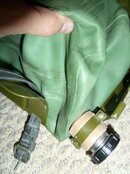Sam-
The ammo boxes are probably the most effective hermetic sealed containers you can buy. The real ones, military spec or surplus, not the plastic stuff sold as tackle boxes of course.
I've got several, waited for a good sale to get some "new" ones. The used ones I clean up, prime and paint, so there's no surface rusting. Keeping the gasket unpainted means a little patience and extra work. Mainly I use them just that way, clean and sealed. But I do have a container of pyrotechnics, which have expiry dates. Those decay with the presence of oxygen and moisture. So, the container was loaded, then I tossed in two desiccant packs and two oxygen absorber packs and closed it up. With a label on the outside saying it is hermetically sealed, not to open it, and the contents. I've also done the same thing in Pelican cases for equipment that might develop surface rust while stored.
With oxygen absorber packs, when you order them they come in sealed mylar bags. Once you open the bag, they are all going to start absorbing oxygen no matter how you reseal them. (Mason jars are probably best.) So don't buy huge bags, and be generous with the packets when you do use them. You can't use too many, they stop working when the oxygen is consumed in a space. Desiccant packets can often be reused just by slowly heating them, and ordered with color spots to indicate they are used/good. You can use the ones that electronics and things are shipped with, but they never have the color spots and I'm never sure these days which ones are what kind of absorbers, so I just buy new packets.
The book will certainly appreciate that. There's probably an optimal storage environment for it and 100% dry probably is too dry, but I suspect it will "rehydrate" to normal after it has been out for a few days. It just might be brittle when it is too dry. The lack of oxygen and light will certainly help, unless it is printed on acidic paper, in which case it is going to age anyway.
Yeah, I hate putting something in storage and then ten years later going to fetch it and finding...crumbs. These days there are many copies of Pelican cases, some cheap some inexpensive, it pays to look around.





